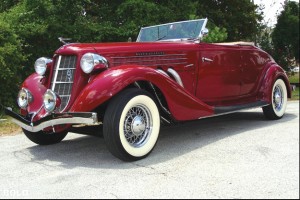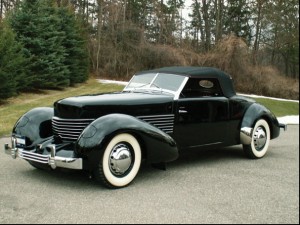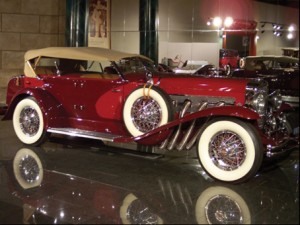Registered with the Registrar of Newspapers for India under R.N.I 53640/91
Vol. XXVI No. 09, August 16-31, 2016
ACDs not among our vintage wealth
by V.S. Kylas Secretary of MHMC
Six pages for Madras Week 2016
 Auburn
Auburn
Travel down memory lane with me and let’s recall the array of cars that once were a part of the Madras scene.
The ABC of cars is ACD, these scene-stealers (even now they are great crowd-pullers): Auburn, Cord and Duesenberg. Their streamlined contours painstakingly designed, coupled with massive muscle power is a delight to watch even now in pictures, movies or museums.
Madras can be proud of the fact that we did have a dealership selling these cars, M/s. Rajagopal Motors, just behind Mount Road on Ritchie Street. Sadly, no one in Madras has one of them, even in a vintage car collection, today.
Apart from these, we also had quite a number of cars from Nash, Rolls Royce, Lagonda, Allegro, Renault, Mercedes Benz, Volkswagen, Skoda, Fiat, Alfa Romeo, Bentley, Daimler, Delage, Willys Knight, Kaiser, Rambler, Jeeps, Hudson, Hupmobile, Sunbeam, Humber, Cadillac, Buick 8, Pontiac, Oldsmobile, and Chevrolet. We also had Ford T models (Tinlizzy), Ford Tudor, Ford Prefect, Ford Anglia, Ford Popular, Ford Consul, Ford Zephyr, Zodiac, Taunus (from Dagenham Ford Motors in the UK) and we had Ford Teardrop model V8 1939 and then Ford Mercury V8, Ford V8 Custom, Ford Thunderbird, Custom et al.
Madras can also boast of having had the low slung yet very distinguished Studebaker models – the famous Aero Nose, the Champion, the Landcruiser, the Commander and the President, apart from DeSoto. They were a cut above the rest as they came with the overhead valve engine versions which were much ahead of their contemporaries – Ford and Chrysler. Film celebrities used to patronise Chryslers, Dodge Kingsway and Plymouth Savoy for their flamboyant fins and excellent contours along with their trims which used to be stunners, had to contend with low performance, their 0-60 miles per hour being slow when compared to the Studebakers. I have personally witnessed in the 1960s a Studebaker Landcruiser V8 racing past Plymouths and Dodges. This reminds me of Lee Iacocca mentioning in his book that the Ford V8, despite having a side valve engine, was no patch when it came to acceleration, 0-60 miles per hour, while competing with GM’s Buick 8 inline overhead valve engine. The Ford V8, however, used to pip other at the poles because of cutting edge technologies that Ford had developed after World War II when the American war veterans had a lot of money and buying power and used to prefer the V8s.
 Cord.
Cord.
Colonial rule ensured that Madras had its array of English cars from the factories of Austin, Bentley, Daimler, Morris, Rolls, Humber, Jaguar, Landrover, Sunbeam, Singer, Triumph, Allegro, Standard, Ford, Hillman, Riley, and Vauxhall. The Austin range of cars comprised the Austin 7 Chummy, Ruby, Austin 8, Austin 12/4, Austin 16/4, Sheerline, Austin Princess, while the Morris range included the Cowley, the Bullnose, the Cut-door Morris, Morris 8, Morris 10, MG series, and the Morris 1000 (affectionately called the Tiger 1000 because of its peppy engine). There were also several models of Jaguar, Flying Standard, Standard 8, Standard Vanguard phases 1, 2 & 3, Ensign V6 Estate, Triumph Mayflower, Triumph Herald, Standard Super 8 basic model, Standard Super 10, the Pennant and Standard Companion. We also had the Roots group of cars in Madras like the Singer roadstar, Riley and Hillman series, starting with Minx, the Imp, Hunter etc. From Italy cars are the Bug Fiat, Fiat Millicento, Fiat 1100, Super Select and Fiat Delite to Madras. The French, East and West German, and Czechoslovakian cars too plied on Madras roads, like the Mercedez Benz, Volkswagen, Opel, Peugeot, Renault, Citroens, NSU and Skoda. There was also Russian cars like the Moskovich, Tatra and Volga. And GMs Australia’s gave us Caprice and Holden.
Madras has the unique distinction in this part of the country of giving importance to car registration numbers. Looking at the numbers you could guess who the owner was. Some of the numbers which were very prominent in those days were 2772, 7670, 9100, 5545, 786, 5445, 2313, 5193, 1962, 5515, 9682, 2838, 4777, 6777, 4852, 2919, 1, 7, 2829, 4077, 123, 4, 2728, 1917, 7374, 747, 7470, 5052, 4786, 7293, 7294 and 6666. There were also the numbers with the last three digits being 331 – combinations like 1331, 2331, 4331, 5331, 7331, 8331 apart from stand alone 331 with several prefixes in each of the series from MSC onwards. Kamaraj’s Chevrolet Styline bore the number MDT 2727 and MGR’s Ambassador MGR 4777. Some of the prominent industrial houses had numbers totaling to 9. Madras car owners attached a lot of importance to superstitious beliefs and none of them would go near a number totalling 8 as it was considered a jinxed number. But when it came to cars, the suffix for cars like Buick 8, Morris 8, Austin 8, Standard 8, Ford V8 were not a bar.
 Duesenberg.
Duesenberg.
I recall an incident that happened in the 1980s during the launch of the Allwyn Nissan Cabstar 576. The date was fixed for the launch of the vehicle on an all-India basis as this was one of the first JVs in India to manufacture commercial vehicles. Just days before the launch, the Japanese team were taken aback when the dealers appointed, especially those from the South had a peculiar request. They wanted the name Allwyn Nissan cabstar 575, which totalled 8, to be changed to Allwyn Nissan cabstar 576. Even though the Japanese initially resisted this, they finally had to relent and accept 576 which totalled 9.
Another of Japanese story. The Japanese are very good as reverse engineering and perfecting any existing design. A team of four Japanese were at GMs Detroit design office in the early 1950s wanting a new prototype to be designed by GM for manufacture in Japan. After the initial round of discussions, they finally zeroed in on a model and wanted the drawings and prototype to be readied. GM indicated 8-10 weeks for development; the Japanese insisted on four weeks. The Chief of GM commented: “That soon” And a name was born – Datsun!
Madras once had two Plymouth Stationwagons, MSY 7293 and MSY 7294, white coloured cars used by the Chief of Police. They had extra boot space to carry the “Walkie Talkie” Radio equipment. The name Stationwagon was coined by the Americans for all models which had an estate version with a door at the back. The name was on account of the extra boot space required to fetch all traveller’s bags while commuting from the railway station.
Many of the cars mentioned in this article will be exhibited by the Madras Heritage Motoring Club on Sunday the 28th at Turyaa Hotel on OMR, a kilometre away from Tidel Park. The Club was founded in 2002 with Patron Members M. Saravanan, Suresh Krishna and the late A. Sivasailam succeeded by Mrs. Mallika Srinivasan. Balraj Vasudevan was the Founder President, V.S. Kylas, the Founder Secretary, and the Committee Members were Ranjit Pratap, M.S. Guhan, Viji Joseph and Sumanth Chaganti. Members own close to 200 vintage cars and 150 bikes.
The uniqueness of the Club is that it has a lot of members who have single cars as well as members who have fleets of cars. All feel at home and the bonding is excellent. The Club also helps members restore their cars and bikes by providing the necessary expertise. On the anvil are plans to have the Club’s own museum-cum-state-of-the-art education platform for automobile engineering students to learn more about restoration of vintage cars, apart from having cut-sections of the old and new for students to get a glimpse of car design then and now.

